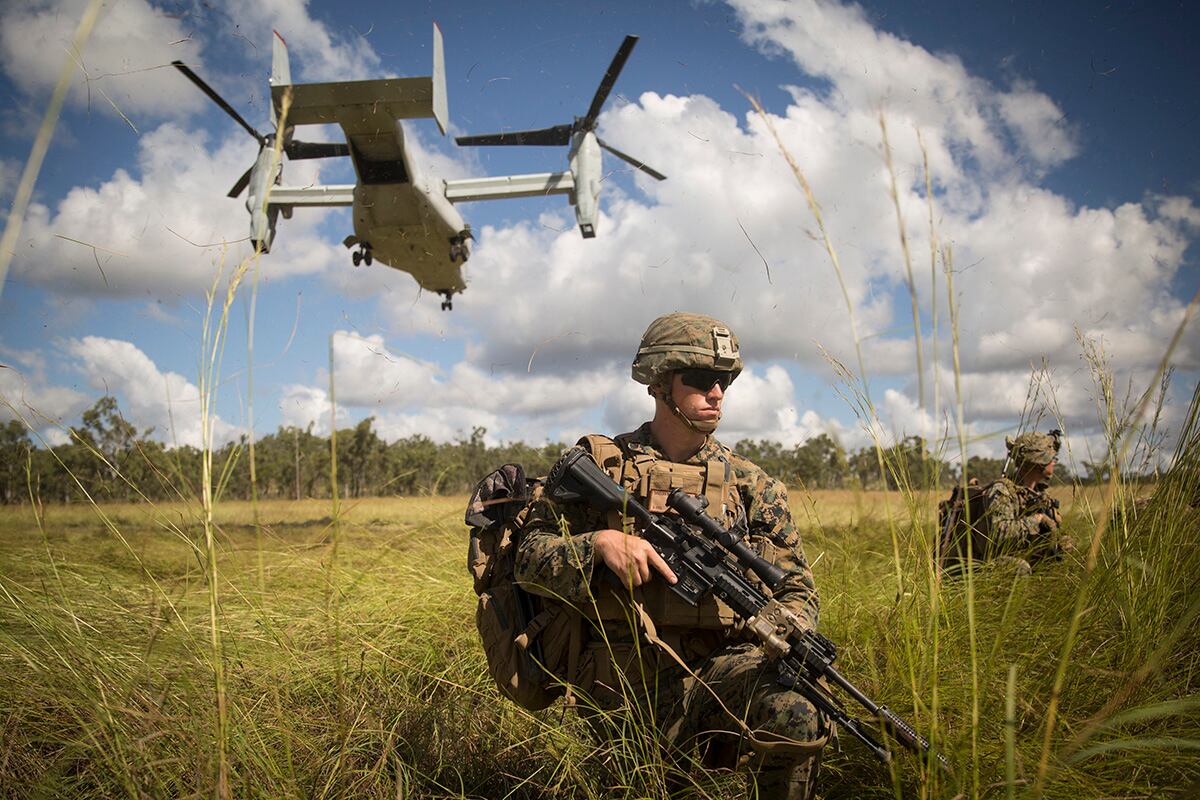The Marine Corps is searching for new virtual reality flight simulators to bring more pilots into the service amid a pilot shortage.
Virtual reality technology is evolving quickly and these simulators can provide a “strikingly realistic experience” to potential applications that currently isn’t available in traditional recruiting settings, according to Maj. Brian Spooner, an aviation assistant for officer procurement with the Marine’s Western Recruiting Region.
That’s why Marine Corps Recruiting Command is looking to procure at least six virtual reality flight simulators the Marine Corps Flight Orientation Program could share with applicants at recruiting events, per a request for information the service issued in May.
Spooner said AAOPs have been eyeing updated simulators for roughly two years and that he had the opportunity to learn more about how the service could incorporate them into the Marine Corps Flight Orientation Program at the Interservice/Industry Training Simulation and Education Conference in 2019.
“All of the AAOPs in Marine Corps Recruit Command felt the VR platforms would allow us to travel easier, spend less money, offer a more reliable recruiting platform, and have the ability to upgrade the technology over time,” Spooner said in an email to Marine Corps Times.
Spooner said that the Marine Corps already has multiple virtual simulators in its arsenal used while visiting campuses, career events, and airshows, including six Redbird F-35 simulators and 26 Eleetus simulators that can replicate flights for MV-22 Ospreys tilt rotor aircraft, AH-1Z Viper helicopters and F/A-18 Super Hornet fighters.
The Navy announced in January 2019 that it would purchase an additional 25 AH-1Z Vipers from Bell Helicopter, after already issuing a contract in August 2018 for 29 AH-1Z Vipers to replace the AH-1 SuperCobra.
Spooner said the service is aiming for the new simulators to accommodate the F-35B/C Lightning II fighters, and the Vipers or Ospreys.
RELATED

It’s unclear how much the Marine Corps is expecting to shell out for these new simulators, but the objective is to obtain simulators that are less expensive and easier to haul to Marine Corps recruiting events.
“At this stage of the contracting process we are seeking information from vendors about the capabilities they have on offer, before we formulate an eventual request for proposals,” Spooner said. “So it is too early to know where the competitive bidding process could land, but we expect these systems would be significantly smaller, more portable and less expensive than current ones.”
Whereas the current simulators travel in 35-foot trailers that are either leased or have been purchased for $110,000, the new simulators should have equipment one person can carry and fit in the back of a 15-passenger van, or on a commercial flight.
“The intent is to have these units be stand-alone or supplementary to the local officer selection team’s recruiting efforts,” Spooner said.
Minimum equipment includes virtual reality goggles, a laptop, flight controls, and a case, according to the service’s RFI.
The Marine Corps Flight Officer Program originated in the 1970s, and historically took potential applicants for a spin in leased Beechcraft King Air and Bell Jet Ranger aircraft.
“In 2005 I was a civilian sitting next to a fleet military pilot receiving instruction at 5,000 feet executing an instrument approach for the first time,” said Spooner, who was a MV-22 pilot. “That experience will sell just about anybody wanting to fly in the military.”
“As most of the AAOPs will agree, there is no substitute for actually taking a prospective aviation applicant flying, but VR comes close,” Spooner said.
Military.com first reported the Marine Corps’ interest in the virtual reality simulators.
Despite the COVID-19 pandemic, the Marine Corps Recruiting Command told Marine Corps Times in May that it remains “cautiously optimistic” it will meet its recruiting goals this year. However, the Marine Corps -- along with other services -- have grappled with a pilot shortage for years.
In response, the Marine Corps last June offered up to $280,000 in bonuses for Osprey and F-35 aviators if they signed eight-year contracts. Likewise, the Marine Corps offered $30,000 bonuses for former captains and majors to return to the active reserve component for three years.
But like the rest of the service, Spooner also said the Marine Corps expects that the service’s aviation program will also continue to meet its recruiting targets.
“Our projections indicate a fairly steady stream of applicants to our aviation program over the next couple years,” Spooner said. “Marine Recruiting has so far been able to meet the demand for military pilots, and the current state of the commercial airline industry will only help to ensure we can select the highest quality aviation applicants who will excel in flight school.”
The RFI said businesses must submit a capabilities package, which will be then used for market research. Responses to the Marine Corps’ RFI are due by July 31, and companies will present their virtual reality simulator to Marine Corps Recruiting Command in the fall for an industry day.





